#nichi illustrations
Text

Playing flutes with Link and Zelda~🎶🎵
This took way longer than it had to. This is a commission for vixraymusic! Go check him out!☺️
#nichi illustrations#legend of zelda#tears of the kingdom#loz tears of the kingdom#totk zelink#zelink#link#Zelda#fanart#music#flutes#nature#hylian#art#digitalart#procreate#illustration
964 notes
·
View notes
Text

#artwork#artists on tumblr#art#my art#digital art#illustration#magicians quest#enchanted folk and the school of wizardry#enchanted folk#magicians quest mysterious times#とんがりボウシと魔法の365にち#tongari boushi to maho no 365 nichi#animal crossing#animal crosing new horizons#animal crossing but harry potter but sims simulation and dating#it has dating#and mystery solving!!!!#gijinka#anime fanart
6 notes
·
View notes
Text

RAHHHHH I LOVE (Somewhat) NOT HAVING A CONSISTENT ARTSTYLE‼️‼️‼️
#magicians quest#magicians quest mysterious times#とんがりボウシと魔法の365にち#Tongari Boushi to Mahō no 365 Nichi#art#ibispaint art#art practice#artists on tumblr#oc art#original art#digital illustration#digital artwork#🤓
2 notes
·
View notes
Text
1-nichi 10-pun shokyū kara hajimeru dokkai 120
New item:
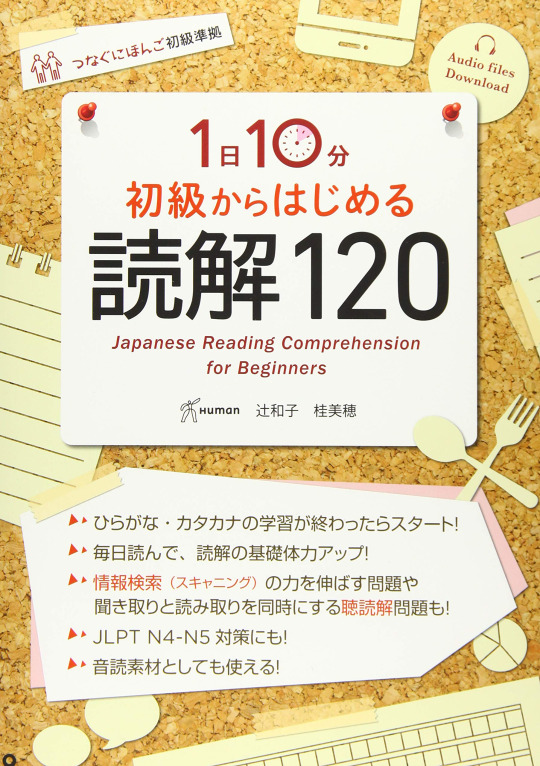
Shelf: 810.783 TSU 1E/2E
1-nichi 10-pun shokyū kara hajimeru dokkai 120 = Japanese reading comprehension for beginners.
by Tsuji Kazuko, Katsura Miho.
Tōkyō : Asuku Shuppan, 2020.
ISBN: 9784866393612
142 pages : illustrations, charts ; 26 cm. + 1 answer booklet (11 pages ; 26 cm.).
Supplementary contents (audio) are available from the publisher’s web page.
Text in Japanese with moderate furigana on kanji characters. English translation on new vocabularies. Spoken word on downloadable MP3 files or streaming audio (Apple Podcast or Spotify) in Japanese.
#japanese language#textbooks for foreign speakers#sound recording for foreign speakers#jlearner#jteacher
0 notes
Text
Ai no Aru Seikatsu Vol.1 〜Cohabitation〜 Sho Nichi (アイのある生活 Vol.1 同棲初日)
Margarine Tengu マーガリン天狗
Copyright Karaage Cycle
Scenario: yaya
Illustrator: Itohara Youji 絲原ようじ
Genre: Student, Lover
Company: Karaage Cycle からあげサイクル
Date: 21 June 2017
Websites to buy from: https://www.stellaworth.co.jp/shop/item.php?item_id=ICVk8HCYVkT
Summary:
You met Kosuke during your time at university and fell in love with each other. Soon you started dating, and after a year and…
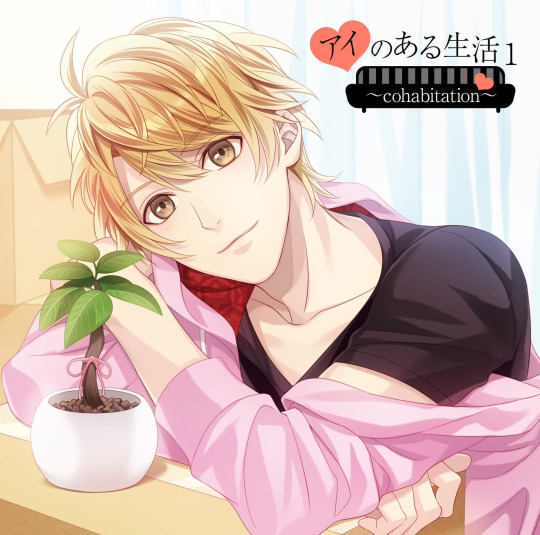
View On WordPress
0 notes
Photo

"Illustration by Sentaro Iwata ... Matsutaro Kawaguchi, product "Jahime-sama" "Tokyo Nichi Nichi, Osaka Mainichi Shimbun (evening edition)" January 1, 1940"
190 notes
·
View notes
Note
do you still take asks? if so, could you explain tanjirou's hanafuda earings? i've seen some people online (like insta and other such places) claim that the design is one of a flower, but i always thought it was of a sun since it was supposed to be like a token for the sun god or something (disregarding possible [and hopefully unintentional] symbolisms coming from ww2)
whenever these people say these, they go back on to the earings being called hanafuda cards, and that hana means flower. i'm not that smart when it comes to japanese things or hanafuda cards specifically, so if you could, can you explain the hanafuda cards and the design on tanjirou's earings?
thank you and i hope you're having a lovely day (love your blog, btw, esp the art and japanese trivia posts)
Hahaha.... my attempted answer to this met so many technical difficulties, this is my third version, I think, hahahaaaaaa. TwT
We shall indeed endeavor to keep this related to the original Sengoku period design of the earrings and their relation to Hanafuda cards, though indeed this is a Heisei/Reiwa period production and it's unavoidable that the similarity would be read in a post-WW2 context. It's not that I don't have things I could say on that, but I prefer not to go in that direction either (and people who choose to use the alternate design have my support).
Short answer, though: nope, not a flower design!
The sun symbolism and its representation of Japan supersedes Muzan’s birth by at least a few centuries, and in its earliest uses with a simple circle to represent it, it wasn’t even always defined by the color red. The bright color red has been, however, long since symbolic of the sun, so it’s unsurprising that at some point the two symbols came together. No one knows who to credit for its design as a symbol to represent the emperor, but it seems this started in the Sengoku period, same time Yoriichi and his mother Akeno were around in the 15th, 16th centuries or so (but hard to say). The imperial use is due to the Shinto mythology that the emperor is descended from the sun goddess, Amaterasu. (I’ve have heard some KnY theorists posit that certain characters represent different gods in the Shinto pantheon and that Yoriichi represents Amaterasu (who indeed has historical male representations), but I don’t buy into those theories.)
While’s it’s not to say Amaterasu couldn’t be beseeched for healing a deaf child, she doesn’t strike me as the first goddess you’d go to for help with that, so I had originally suspected Akeno might have been more of a practicing Buddhist seeking the help of Dainichi-nyorai (the Buddha that represents the sun, if we put it very simply), or that she might had been a follower of the Nichiren sect, which embraced syncretism with Shintoism and used the “Nichi” (sun) symbolism pretty heavy-handedly (that sect tended to encourage a devout following of women, too). That’s as far as I find relevant to read into this side of things, though, for a look at Akeno’s altar shows us a round mirror often used in Shinto worship (some scholars suspect the round shape represents the sun, too, but it’s not at all limited to being a sacred item to represent sun-related deities). However, religion is and always has been complicated, and Akeno may have been a follower of any pure or blended strain of Shintoism and/or Buddhism.
Tl;dr: Akeno has a profound faith in some kind of sun deity.
After all, Yoriichi says this very plainly on this page in Chapter 186, “My mother was a person of very deep faith.”
In addition to her daily prayers for peace, she made the earrings for Yoriichi praying that the “god of sunlight” may shine on and warm his unhearing ears. We have no further definition of this “god of sunlight,” so it could be Amaterasu, Dainichi-nyorai, any possible unnamed sunlight god she might have had faith in (Gotouge tends to borrow heavily from a lot of different religious traditions without narrowing them too far into any particular sect or strain). We may not be meant to read this in such detailed historical context as Amaterasu because it is left so ambiguous, but the art representing the sun is pretty ubiquitous throughout Japanese culture by that period.
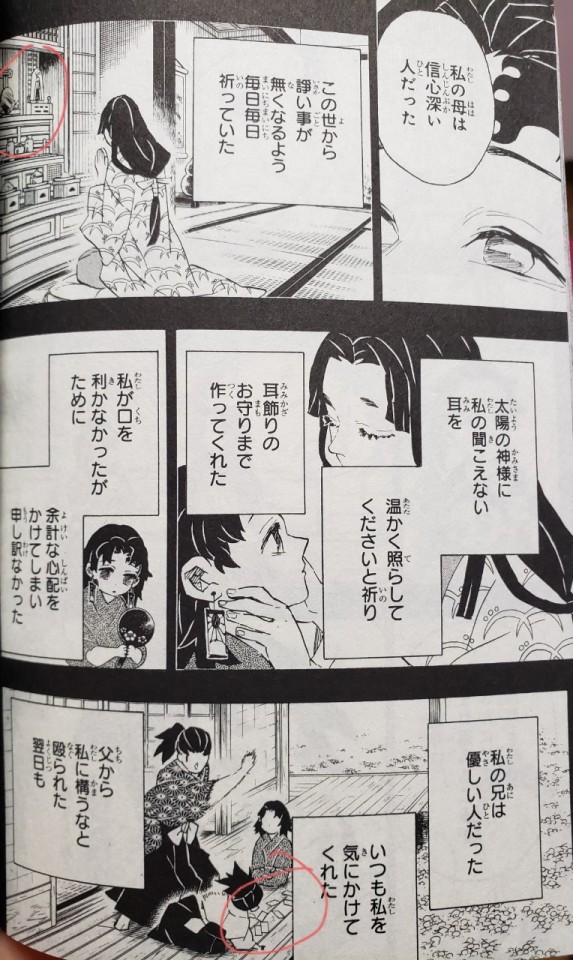
And would you look at that, little Michikatsu and Yoriichi were playing a card game! Hmm, I wonder what?
While I cannot claim anything one way or another about how Gotouge and her editors saw it or what they may think of it being seen that way abroad, the rays inevitably make it seem similar to the 16-ray naval flag, and the earlier color illustrations did have red lines. However, at some point the design settled into using 11 thin black lines only, with an emphasis in Gotouge’s character design notes (from the first fanbook) on the pooling thickness at the ends of the lines. This feels to me a bit like inky brushstrokes, and there is also design emphasis on the thick lines at the tops and bottoms of the earrings. These details, as well as the notes (cropped out of the image below) about the movement and weight of the earrings around Tanjiro’s face make them seem to have the thickness of light cardboard, which altogether makes them very similar to Hanafuda cards.
Most specifically, doesn’t it look like this card featuring pampas grass and the moon?
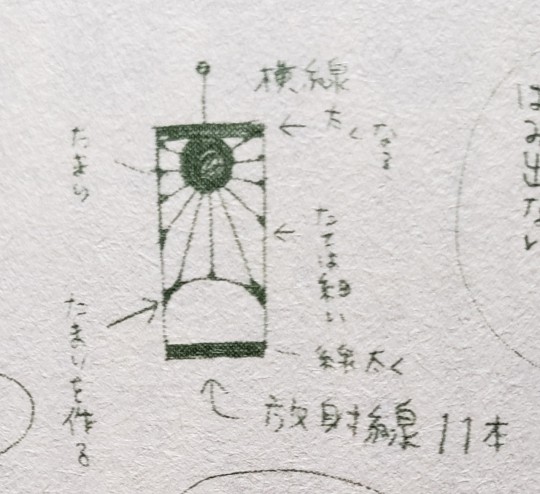
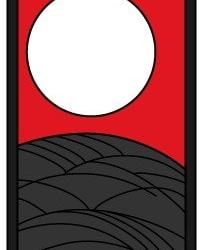
While Hanafuda does literally mean “flower cards” and there are designs grouped around certain themes (even if the theme itself isn’t a flower, the design will typically incorporate a plant), I feel fairly confident saying the design of Yoriichi’s earrings is not a flower, and indeed the sun.
Primarily because these earrings aren’t Hanafuda cards!
Hanafuda technically didn’t exist until after Yoriichi’s time, and was adapted from a Portuguese card game. Said game was initially illegalized at the same time Christianity was illegalized, but the Edo public loved their card games, and reinvented it every time some previous version was outlawed for its use in gambling. Even today, there are many, many different versions or reiterations of Hanafuda under the same or different names. I have never played though, and will not attempt to explain it. ^0^;; (I have cousins who grew up playing the Hawaiian version, though.) It was finally legalized in the Meiji period, and the first fanbook even lists this as one of Zenitsu’s favorite games.
By the Taisho period anyone would had been familiar with it, leading Muzan to describe Tanjiro to Yahaba and Susamaru as “the demon hunter who wears earrings that look like Hanafuda cards.”
While my research didn’t take me this far, I’m willing to bet card games with similar illustrations existed far prior to Hanafuda, and whether or not Akeno would had been influenced by them is anyone’s guess. But as she made them as religious items, that still makes them not game cards. I do assume she used high quality washi paper though, the finest she could afford as the wife of a high-ranking samurai. Good washi is strong enough to last for centuries, and even used to be used for making clothing because it’s so durable. But it’s also lightweight, she wouldn’t want to weigh Yoriichi’s little ears with precious metals or anything like that, I believe!
This all being said, I have most certainly noticed a trend of actual Hanafuda cards being used in accessories, everything from earrings to necklaces to charms to hang on facemasks to manicures. The only time I’ve seen this sun design has been in clear reference to Kimetsu no Yaiba, though!
This went in a lot of different directions, Anon, but I hope that clears things up about the sun and Hanafuda connections more than it clouds everything in unnecessary details. XD
#KnY fandom theories and meta#KnY nerdery#KnY reference#tsugikuni yoriichi#tsugikuni akeno#kimetsu no yaiba#demon slayer
41 notes
·
View notes
Text
I wanna see the Nichi-tober drawn by Nichijou fan illustrators !!
pls announce 31 THEME of Nichi-tober
6 notes
·
View notes
Note
hii, dont mean to bother but what do u use for editing? ur stuff is so gorgeous wow <3
hello!! aww not at all 🥺
on my phone i use picsart, nichi, vsco & lightroom mobile,,
if i use my laptop i use adobe photoshop, illustrator, after effects & lightroom! occasionally i use medibang paintpro to add some hand drawn details~
and thank you so much! that really means alot 🥺 have a lovely day! 💗💗💗
1 note
·
View note
Text

I made yet another Secret Santa art trade in December 2022 for my friend stevenmaddox_art! This time I made Aizawa Shouta (or Shota). I always associate him as a car person 🐈
#nichi illustrates#fanart#bnha#boku no hero academia#my hero academia#mha#aizawa sensei#aizawa shota#aizawa shouta#cat#kitty#kitten#aizawa fanart#digital fanart#digitalart#art#illustration#nichi illustrations
231 notes
·
View notes
Photo

Pumpkin Box featuring Ema and Shiro as illustrated by 13-Nichi wa Kinyoubi? series mangaka, Enomoto Chizuru. This item was bundled with the October 2003 issue of Ribon magazine and scanned from my personal collection.
#13 nichi wa kinyoubi?#13 nichi wa kinyoubi#enomoto chizuru#chizuru enomoto#scan: hotwaterandmilk#furoku#ribon#shoujo manga#halloween
20 notes
·
View notes
Text
Nampō Roku, Book 2 (34): (1587) Fourth Month, Thirteenth Day, Morning.

34) Fourth Month, Thirteenth Day; Moring¹.
◦ 4.5-mat [room]².
◦ [Guests:] Tsushima no kami [對馬守]³; Yanagawa Shōken [柳川將監]⁴; Sōkyū [宗及]⁵.
The [things that were] displayed, and the way the utensils were placed, were the same as on the Eighth Day⁶.
[However,] the cookery included fish⁷.
◦ Mizusashi Shigaraki [水指 シカラキ]⁸.
_________________________
¹Shi-gatsu jū-san nichi, asa [四月十三日、朝].
The Gregorian date was May 20, 1587.
This is another of the chakai that was not included in Kumakura Isao’s modern Japanese version of the Nampō Roku.
In Shibayama Fugen's manuscript, the date was given as Fourth Month, Twenty-third Day (and so it is numbered in that way in his commentary). Tanaka Senshō's manuscript, however, agreed with the Enkaku-ji version.
²Yojō-han [四疊半].
This was the 4.5-mat room in Rikyū's official residence.

As during the previous chakai, an ō-ita [大板] was arranged on the utensil mat -- probably on the right side of the mat as shown (as would have been necessary during the previous gathering).
³Tsushima no kami [對馬守].
This seems to refer to Sō Yoshitoshi [宗義智; 1568 ~ 1615]* (though he was not officially given this title until 1588†). He was a nobleman, and eventually attained the junior grade of the Fourth Rank as imperial chamberlain (jijū [侍従]).
__________
*His given name is sometimes pronounced Yoshitomo [義智], though it is unclear which pronunciation he actually used.
†Which admits the speculation that this entry was subsequently modified.
⁴Yanagawa Shōken [柳川將監].
In the Rikyū Hyakkai Ki [利休百會記], this man (who also was the ji-kyaku to Sō Yoshitoshi as shōkyaku) is named as Yanagawa gonsuke [柳川権亮]. Some scholars have suggested that this was possibly Yanagawa Shigenobu [柳川 調信; 1539 ~ 1605] -- though primarily based on his dates* -- but the identity of this individual is really unclear. He seems to have been an assistant or attendant† of Sō Yoshitoshi, who was surnamed Yanagawa.
Possibly Yanagawa [柳川] is a variant form of Yanagawa [柳河], which was the name of a clan located in Chikugo no kuni [筑後國], in modern-day Fukuoka Prefecture; though even if this were the case, the individual in question has not been satisfactorily identified.
While Shibayama Fugen states in his brief commentary on this chakai that this person has not been identified, Tanaka Senshō indicates that his sources suggest that Yanagawa Shōken was one of Rikyū's disciples‡.
___________
*But looking at the career of Shigenobu suggests that, even at this point in time, he would have been a much more important man than this record seems to imply.
†Gonsuke [権亮] is a variant of gonsuke [権助]. These terms can mean an assistant to an official (i.e., a vice-official); but gonsuke can also be used to refer to a personal attendant (which, in the case of a nobleman, would hardly have been a man of mean birth or low social standing). His appearance with Sō Yoshitoshi suggests some such relationship.
‡However, the presence of Tsuda Sōkyū (who likely acted as Rikyū’s assistant) seems to argue against either of the others being very experienced in chanoyu.
⁵Sōkyū [宗及].
This refers to Tsuda Sōkyū [津田宗吸; ? ~ 1591], one of Rikyū's closest personal friends, and perhaps the man whose sensitivity and taste in chanoyu he most admired among all of his contemporaries. It is perhaps indicative of his delight in this man that, over the course of their lifetimes, Sōkyū's name is mentioned more often than any other in the guest lists of Rikyū's gatherings. And as for the passage in which Rikyū describes Sōkyū’s tea (preserved in Book 7 of the Nampō Roku), it is nothing short of gushing in its praise*.
Sōkyū, together with Rikyū, and (Rikyū's nemesis) Imai Sōkyū [今井宗久; 1520 ~ 1593], were considered the three greatest chajin of their generation.
On this occasion, Sōkyū probably acted as Rikyū’s hantō [半東] or assistant.
__________
*Some have questioned why, if Sōkyū’s chanoyu was truly as wonderful as Rikyū describes, he had not been better dealt with by history. And the simple fact appears to be that, while Sōkyū built up the wealth of the Tennōji-ya house under Nobunaga’s patronage, he gave his support to Akechi Mitsuhide in the aftermath of Mitsuhide's treachery and Nobunaga’s seppuku (in much the same why that Rikyū did to Hideyoshi). And while Hideyoshi seemed to forgive him, and retained his services as one of his sa-dō [茶頭], this unfaithfulness toward their lord left a bad taste in Hideyoshi’s mouth, for which Sōkyū paid with his reputation.
⁶Shoji kazari, oki-awase tomo ni yō-ka dōzen [諸事カサリ、置合トモニ八日同前、].
According to Shibayama Fugen, kazari [飾り] means specifically the objects displayed in the tokonoma*, while oki-awase [置合] refers to the arrangement and disposition of the utensils (on the utensil mat).
However, apparently the mizusashi was changed for this chakai†.
This phrase (and the next) end with a tōten [讀點 = 読点], or comma. This suggests that all three phrases were originally parts of a single sentence, and were separated by Tachibana Jitsuzan (perhaps for clarity, or to emphasize each of these points separately).
__________
*The kakemono and the hanaire.
†On the Eighth Day the mizusashi was a kiji-tsurube; but that was used because Rikyū had decided to serve tea using the water from a famous well in Sakai (perhaps a pretext to buy himself time -- since the unexpectedly early arrival of his guests surely threw his plans into confusion: thus the “delay” could be blamed on the waiting for the tsurube of famous water to arrive, since water could not be drawn until dawn had broken).
⁷Ryōri ha sakana [料理ハ魚、].
This means that the cooking used fish, or (some of*) the dishes offered on this contained fish.
This statement is in contrast to what was served on the Eighth (when the earliness of the hour precluded the inclusion of anything that was not already present in the house -- Rikyū apparently included cold food that had been left over from the previous evening's meal -- since fresh fish could not be kept overnight).
__________
*Every dish did not contain fish, of course. Rikyū's point seeming to be that fish was included as is usual during most gatherings.
⁸Mizusashi Shigaraki [水指 シカラキ].
This was Rikyū's Shigaraki mizusashi (it is shown below).
To illustrate the things used at this gathering (according to what Rikyū wrote in his entry for the Eighth), then:
○ Shoza [初座]:
◦ in the toko, Mokuan Rei-en’s [黙庵霊淵; ? ~ c 1345] painting of the three monk-poets Hánshān [寒山], Shí-dé [拾得], and Fēng-gān [豐干] (along with a tiger), known as Shi-sui zu [四睡圖] (“Picture of the Four Sleepers”);

◦ on an ō-ita, Jōō's small bronze Chōsen-buro [朝鮮風爐],
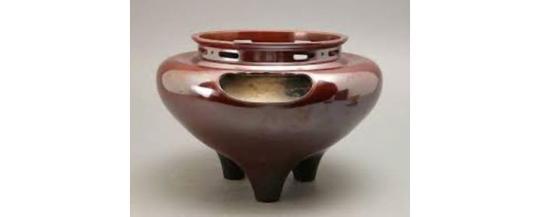
◦ in which was arranged the (second) small unryū-gama [小雲龍釜];

◦ also on the ō-ita was placed the habōki [羽帚]*,

◦ and Rikyū's ruri-suzume kōgō [瑠璃雀香合].

▵ Other than the fact that the menu included fish, nothing else can be said about the food served at this gathering.
○ Goza [後座]:
◦ in the toko†, the large, wide-mouthed bronze hanaire‡ (this hanaire is now known as Kine-no-ore [杵のをれ]), resting on an usu-ita [薄板]**,

◦ perhaps containing a botan [牡丹] (a flower of the tree peony††);
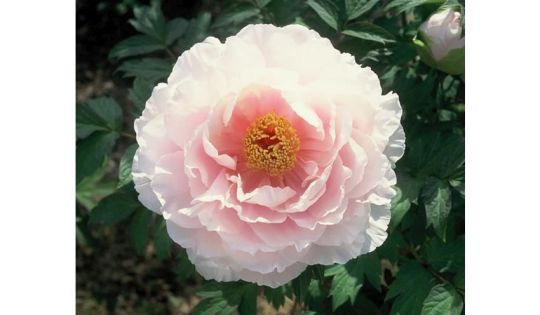
◦ Rikyū's Shigaraki mizusashi [信樂水指] was placed on the utensil mat to the left of the ō-ita furo (on which the hishaku may have been placed),

◦ with the tea container (a ko-natsume [小棗], probably tied in its shifuku‡‡)

◦ and his Soto-ga-hama [外ヵ濱] ido-chawan arranged in front of it;

◦ the chashaku (which was resting across the mouth of the chawan) was an ori-tame [折撓] that Rikyū had made himself;

◦ and the futaoki and koboshi were a take-wa [竹輪] and mentsū [面桶].

◎ In fact, it seems that rather than simply replicating the previous chakai (as his own notes seem to suggest), Rikyū, on this occasion, staged the gathering as he originally conceived it (something that was made impossible, on the Eighth, by the unexpectedly early arrival of his guests).

◎ With respect to the kane-wari, Tanaka Senshō’s explanation of the arrangement of the ō-ita for the shoza (which was included in his notes on the previous chakai) can be illustrated as above. Since neither the kōgō, nor the habōki, contacted a kane, they had no impact on the total (the toko had the kakemono, and so was han; the room had the ō-ita furo, and so was also han: han + han is chō, which was appropriate for the shoza).
As for the goza, the hishaku was probably located in the same place as the habōki***; while the mizusashi (with the ko-natsume and chawan arranged in front of it) was placed to the left of the ō-ita. The toko (with only the chabana present) would have been han, while the room had the ō-ita and the mizusashi and things arranged with it, and so was chō: han + chō is han, which is correct for a chakai held during the daytime.
___________
*The habōki was made from three feathers between 9-sun and 1-shaku long, and so was similar to the kind of habōki that are in general use today.
†While Rikyū may have placed the hanaire in front of the kakemono (resting on an usu-ita, on the floor of the toko), in fact that was probably done on the previous occasion specifically because Rikyū decided to display no other utensils on the utensil mat (he spontaneously decided to conduct that gathering based on the form of the hakobi-temae [運び手前]). On this occasion, the mizusashi and other things were arranged on the utensil mat as usual, and so it seems most likely that Rikyū removed the scroll and displayed the chabana by itself during the goza.
‡Rikyū refers to this hanaire as a kuchi-hiro kane no hanaire [口廣カネノ花入], which means a wide-mouthed metal flower container.
**Rikyū's usu-ita [薄板] was of the variety called the yahazu-ita [矢筈板] today: it measured 1-shaku 3-sun 2-bu by 9-sun 2-bu. The notched edge was uneven, and the wider side was placed above (since this ita was derived from a meibutsu naga-bon, and the wider side represented the rim of the tray; while the other represented the foot).
††Perhaps pink, since that was the color preferred by chajin of Rikyū's period -- though at that time botan also came in magenta, purple, and white. The flower, even if the same color, would have been a different one from that displayed on the Eighth, since customarily a flower was used only once -- and then discarded.
‡‡Though it could also have been tied in a small purple furoshiki (the size of the modern temae-fukusa).
At any rate, the tea container would have had to be tied in something -- to protect the tea.
***Since placing the futaoki next to the handle of the hishaku would be a replication of the arrangement used during the shoza, Rikyū probably left the take-wa out of the goza’s initial arrangement -- though he may have placed it on the ō-ita (along with the hishaku) at the conclusion of the temae.
4 notes
·
View notes
Photo
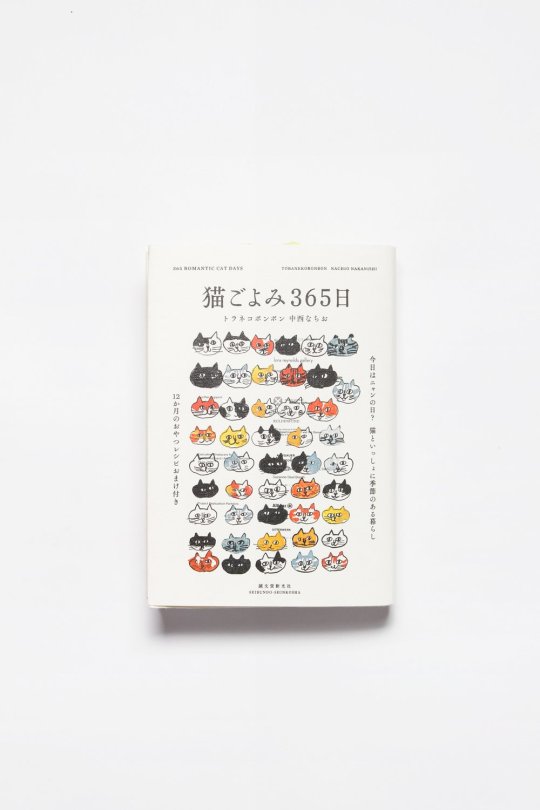


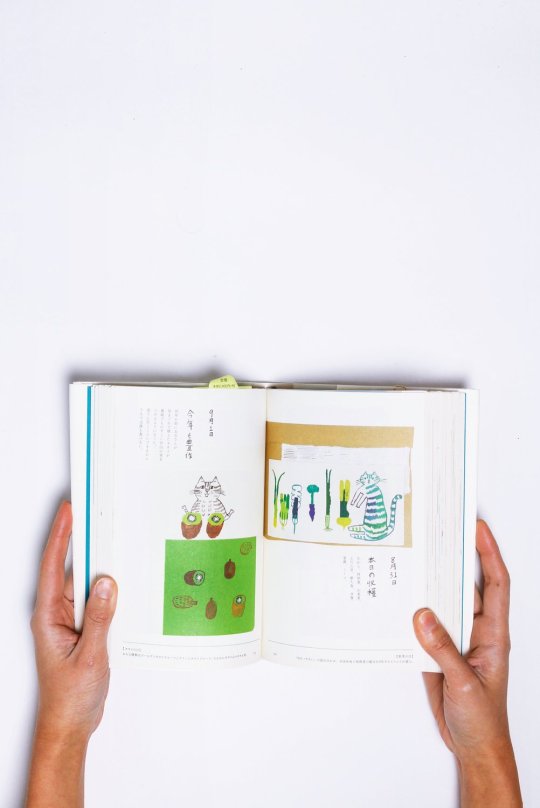

Neko Goyomi 365 Nichi
Author: Nachio Nakanish
Illustrator: Toranekobonbon
0 notes
Text
Fujita sarubēji
New item:

Shelf: 555.9 MAT
Fujita sarubēji : Nihon no sengo fukkō Nichi-Gō shinzen ni daikōkenshita Fujita Ryūgo shi to kazoku.
by Matsudaira Mina.
Tōkyō : Seruba Shuppan, 2023.
ISBN: 9784863677944
159 pages : illustrations, portraits ; 19 cm.
Includes bibliographical references (page [159]).
Text in Japanese.
0 notes
Text
Global Daptomycin Market 2021 Research Analysis, Innovative Services And Advanced Applications, Future Growth Till 2028
Daptomycin market is expected to gain market growth in the forecast period of 2021 to 2028. Data Bridge Market Research analyses the market to account to USD 5,509.53 million by 2028 growing at a CAGR of 4.27% in the above-mentioned forecast period. The growing awareness amongst the patients regarding the benefits of the daptomycin which will further create new opportunities for the growth of the market.
The major players covered in the daptomycin market report are Teva Pharmaceutical Industries Ltd; Merck & Co., Inc.; Cipla Inc.; Pfizer Inc.; Biological E Limited.; Dr. Reddy’s Laboratories Ltd.; Mylan N.V.; Fresenius Kabi USA; Nichi-Iko Pharmaceutical Co., Ltd.; Sagent Pharmaceuticals, Inc.; Novo Holdings A/S; HISUN USA, inc.; Jiangsu Hengrui Medicine; Huadong Medicine Co.,Ltd; CIVICA.; Olon S.p.A.; Zhejiang Medicines and Health; Yacht Bio-Tech Co., Ltd.; Chongqing Daxin Pharmaceutical Co., Ltd.; Socosur Chem; among other domestic and global players. Market share data is available for Global, North America, Europe, Asia-Pacific (APAC), Middle East and Africa (MEA) and South America separately. DBMR analysts understand competitive strengths and provide competitive analysis for each competitor separately.
Get Full PDF Sample Copy of Report: (Including Full TOC, List of Tables & Figures, Chart)@ https://www.databridgemarketresearch.com/request-a-sample/?dbmr=global-daptomycin-market
The study objectives of this report are:
· To study and forecast the market size in global Daptomycin market.
· To analyze the global key players, market value, and global market share for top participants of the Daptomycin market by employing SWOT analysis.
· To classify, illustrate, and forecast the market by type, end use, and region.
· To analyze the market while comparing and forecasting its status between China and major regions, namely, United States, Europe, China, Japan, Southeast Asia, India and Rest of the World.
· To analyze the market potential and advantage, opportunity and challenge, restraints and risks for all the global key regions.
· To recognize noteworthy trends and factors driving or inhibiting the market growth.
· To evaluate the market opportunities available for stakeholders by discovering the high growth segments.
· To strategically analyze each submarket with respect to individual growth trend and their contribution to the market.
· To study competitive developments such as expansions, new product launches, agreements, and acquisitions in the market.
· To strategically outline the key players and broadly analyze their growth strategies.
· To analyze and study the sales, value, status (2021) and forecast (2021-2028) for the global Daptomycin market.
· To analyze the top players in North America, Europe, China, Japan, Southeast Asia and India, to study the sales, value and market share of top players in these regions.
· To examine the key players of the Daptomycin market to study the sales, value, market share, and development plans in the future.
Global Daptomycin Market Scope and Market Size
Daptomycin market is segmented on the basis of indication, age group, end-user, and strength. The growth amongst these segments will help you analyse meagre growth segments in the industries, and provide the users with valuable market overview and market insights to help them in making strategic decisions for identification of core market applications.
Based on indication, the daptomycin market is segmented into complicated skin structure infections, bacteremia, and others. Others have been further segmented into methicillin-resistant staphylococcus aureus (MRSA) or superbug infections. Complicated skin structure infections segment will expect to hold the largest market share in the forecast period.
Daptomycin market has also been segmented based on the age group into paediatric, and adult. The adult segment will expect to hold the largest market share due to the increasing number of bacteremia and right-sided infective endocarditis patients.
Based on strength, the daptomycin market is segmented into 350mg, and 500mg.
On the basis of end-user, the daptomycin market is segmented into pharmaceuticals, clinics, and wellness centers.
Enquire Here Get customization & check discount for report @: https://www.databridgemarketresearch.com/inquire-before-buying/?dbmr=global-daptomycin-market
Reasons to Purchase daptomycin Market Report Covered:
The report gives an examination about how daptomycin market will develop in the future.
It studies a range of views of the daptomycin market with the help of Porter’s five forces analysis.
This market report analyzes the product type that is supposed to control the market and regions that are likely to witness the fastest development during the forecast period.
It discovers the new developments, daptomycin market shares and strategies employed by the key market players.
It studies the competitive landscape including the market share of major players along with the key strategies accepted for growth in the past five years.
The report provides whole company profiles covering the product offerings, key financial information, current developments, SWOT analysis and strategies employed by the major daptomycin market players.
About Us:
Data Bridge Market Research set forth itself as an unconventional and neoteric Market research and consulting firm with unparalleled level of resilience and integrated approaches. We are determined to unearth the best market opportunities and foster efficient information for your business to thrive in the market. Data Bridge Market Research provides appropriate solutions to the complex business challenges and initiates an effortless decision-making process.
Data Bridge adepts in creating satisfied clients who reckon upon our services and rely on our hard work with certitude. Get Customization and Discount on Report by emailing [email protected] . We are content with our glorious 99.9 % client satisfying rate.
Contact:
Data Bridge Market Research
US: +1 888 387 2818
UK: +44 208 089 1725
Hong Kong: +852 8192 7475
Email: [email protected]
0 notes